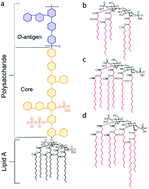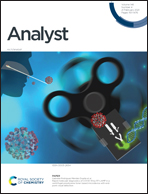Using machine learning and liquid crystal droplets to identify and quantify endotoxins from different bacterial species †
Abstract
Detection and quantification of bacterial endotoxins is important in a range of health-related contexts, including during pharmaceutical manufacturing of therapeutic proteins and vaccines. Here we combine experimental measurements based on nematic liquid crystalline droplets and machine learning methods to show that it is possible to classify bacterial sources (Escherichia coli, Pseudomonas aeruginosa, Salmonella minnesota) and quantify concentration of endotoxin derived from all three bacterial species present in aqueous solution. The approach uses flow cytometry to quantify, in a high-throughput manner, changes in the internal ordering of micrometer-sized droplets of nematic 4-cyano-4′-pentylbiphenyl triggered by the endotoxins. The changes in internal ordering alter the intensities of light side-scattered (SSC, large-angle) and forward-scattered (FSC, small-angle) by the liquid crystal droplets. A convolutional neural network (Endonet) is trained using the large data sets generated by flow cytometry and shown to predict endotoxin source and concentration directly from the FSC/SSC scatter plots. By using saliency maps, we reveal how EndoNet captures subtle differences in scatter fields to enable classification of bacterial source and quantification of endotoxin concentration over a range that spans eight orders of magnitude (0.01 pg mL−1 to 1 μg mL−1). We attribute changes in scatter fields with bacterial origin of endotoxin, as detected by EndoNet, to the distinct molecular structures of the lipid A domains of the endotoxins derived from the three bacteria. Overall, we conclude that the combination of liquid crystal droplets and EndoNet provides the basis of a promising analytical approach for endotoxins that does not require use of complex biologically-derived reagents (e.g., Limulus amoebocyte lysate).

- This article is part of the themed collection: Analyst Recent HOT articles


 Please wait while we load your content...
Please wait while we load your content...
